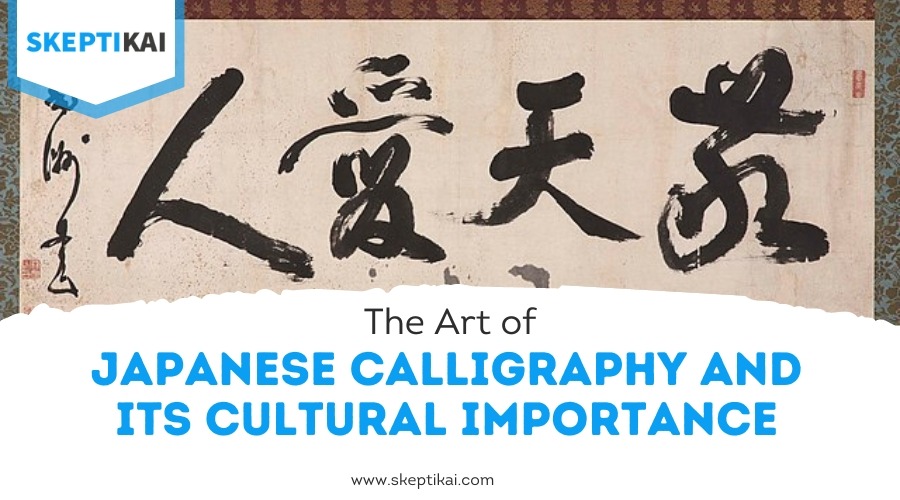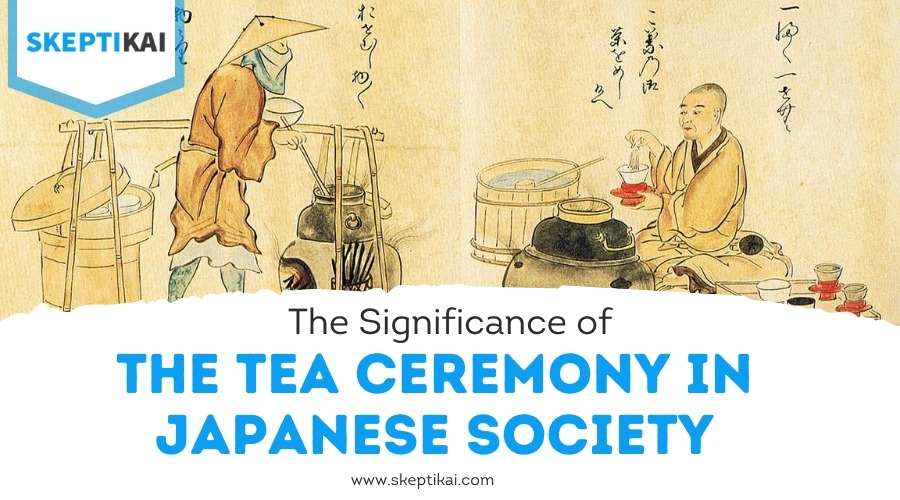Why Is Drinking Tea Important to Japanese Culture?
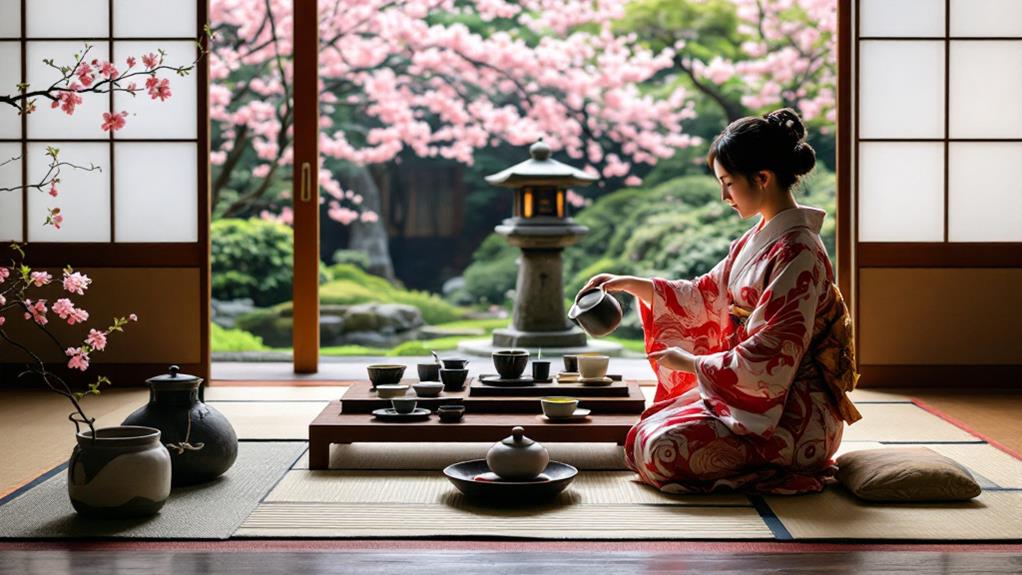
In Japanese culture, tea isn't just a beverage; it's a profound tradition. Drinking tea connects you to a rich history, from its roots in the Nara period to becoming a symbol of social status during the Kamakura age. The art of Chanoyu invites you into a world of harmony, respect, and tranquility, transforming a simple drink into a meditative practice. Tea ceremonies emphasize mindfulness, forging social connections by fostering respect and unity. Through these rituals, you participate in preserving a cultural lineage that's centuries old. Investigate the depth of this tradition to appreciate its full cultural significance.
Historical Significance of Tea
Throughout Japanese history, tea has played an essential role in shaping cultural practices and social rituals. As you investigate the historical significance of tea, you'll uncover how it became more than just a beverage. The tea trade, which began in the Nara and Heian periods, brought tea leaves from China to Japan, marking the beginning of a profound cultural exchange. This trade wasn't just about the product itself; it was a conduit for sharing ideas, art, and philosophy between the two countries. The integration of cultural values into Japanese tea practices is similar to how education incorporates traditional values, enhancing the comprehensive experience and significance.
By the Kamakura period, tea had become a symbol of social status and intellectual refinement. You'd notice that samurai and monks accepted tea for its calming effects and ceremonial importance. During this time, tea gatherings evolved into sophisticated social events, reflecting the values of simplicity and harmony.
In the Muromachi period, Japanese tea culture blossomed further. You'd see tea rooms becoming centers of cultural exchange, where poets, artists, and philosophers converged. Tea was instrumental in forging relationships and fostering a sense of community. As you investigate Japan's past, you'll find that tea wasn't just a drink—it was a bridge connecting people and cultures.
The Art of Chanoyu
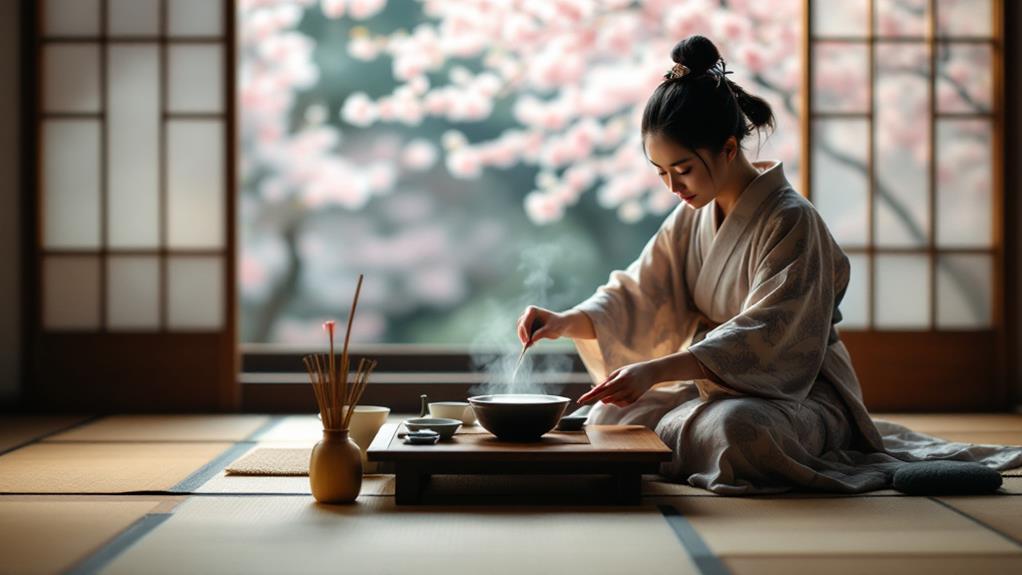
As you investigate the rich tapestry of Japanese tea culture, you'll encounter the exquisite practice of Chanoyu, or the Japanese tea ceremony. This centuries-old tradition goes beyond merely sipping tea; it embodies an art form that emphasizes harmony, respect, and tranquility. Central to Chanoyu is the careful tea preparation, a ritual that transforms the simple act of making tea into a profound experience. You'll find that every movement is intentional, each step calculated to evoke a sense of peace and mindfulness. During Chanoyu, the choice of tea utensils is essential. You'll appreciate the elegance and simplicity of the tools, from the handcrafted tea bowls (chawan) to the bamboo whisk (chasen) used to froth the matcha. Each utensil is not just functional but also a piece of art, often reflecting the season or the personal aesthetic of the host. The chashitsu, or tea house, is designed to foster tranquility and mindfulness, with a ritual purification involving shedding shoes, symbolizing mental preparation. As you participate or observe, notice how these utensils are handled with respect, adding to the ceremony's depth. Through Chanoyu, you'll gain a deeper understanding of how the Japanese value the beauty in simplicity and the grace found in everyday actions. It's a genuine invitation to pause and appreciate life's fleeting moments.
Spiritual and Meditative Practices

In Japanese tea culture, spiritual and meditative practices play a crucial role in enhancing the tea experience. When you engage in tea rituals, you're invited to welcome a moment of serenity and focus. It's about more than just drinking tea; it's about cultivating a state of mindfulness that helps you connect with the present moment. Mindful consumption is key here, allowing you to appreciate each sip and the effort behind the preparation and presentation of the tea. Just as daily routines in Japanese schools foster discipline and mindfulness, tea rituals encourage a similar focus on the present. As you submerge yourself in the ritual, you may find a sense of peace and clarity that goes beyond the physical act of drinking.
To truly understand the spiritual aspect, consider these three components of tea rituals:
- Harmony: Align your surroundings and thoughts, creating a peaceful environment that reflects inner balance.
- Respect: Show gratitude for the tea, the utensils, and the people involved, acknowledging their importance in the experience.
- Purity: Focus on cleansing your mind from distractions, ensuring your full attention is on the ritual.
These practices encourage a deeper connection with yourself and the world around you, making the tea experience both a spiritual voyage and a form of meditation.
Social Connections Through Tea
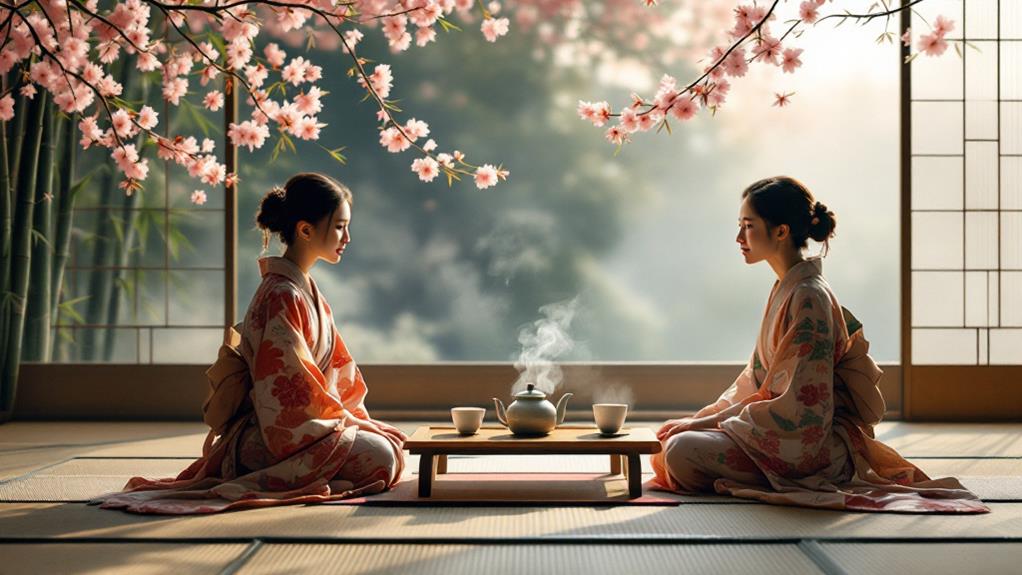
How does tea bring people together in Japanese culture? It serves as a powerful social connector, fostering relationships through tea ceremonies and communal gatherings. When you participate in a Japanese tea ceremony, you're not just sipping tea; you're engaging in a ritual that emphasizes harmony, respect, purity, and tranquility. These ceremonies provide a structured yet serene environment where you can bond with others. The shared experience of preparing and drinking tea creates a sense of unity and mutual respect among participants.
In communal gatherings, tea plays an equally significant role. Picture yourself at a neighbor's home or a community event where tea is served. It's not just about quenching thirst; it's about creating a space for open conversation and camaraderie. Sharing tea encourages interaction, making it easier to connect with friends, family, and even strangers. This ritualistic aspect of tea imbues gatherings with warmth and familiarity, inviting you to relax and engage more deeply with those around you.
Tea as a Symbol of Tradition

Beyond its role as a social connector, tea stands as a profound symbol of tradition in Japanese culture. When you partake in a tea ceremony, you're not just enjoying a beverage; you're engaging with centuries of cultural heritage. The Japanese tea ceremony, or "chanoyu," is a ceremonial ritual that embodies harmony, respect, purity, and tranquility. It's an art form that reflects Japan's deep-rooted values.
Tea ceremonies are more than just a series of actions; they symbolize a connection to Japan's past and an appreciation of its cultural heritage. Here's why tea is so significant as a traditional symbol:
- Historical Roots: Tea ceremonies have been practiced for over a thousand years, showcasing Japan's enduring commitment to its cultural heritage.
- Symbolic Elements: Every aspect of the ceremony, from the utensils to the movements, is rich with meaning and reflects a respect for tradition.
- Cultural Continuity: By participating in these rituals, you're helping to preserve these time-honored practices for future generations.
In embracing tea as a symbol of tradition, you connect with the essence of Japanese culture, appreciating its history and ensuring its future.

